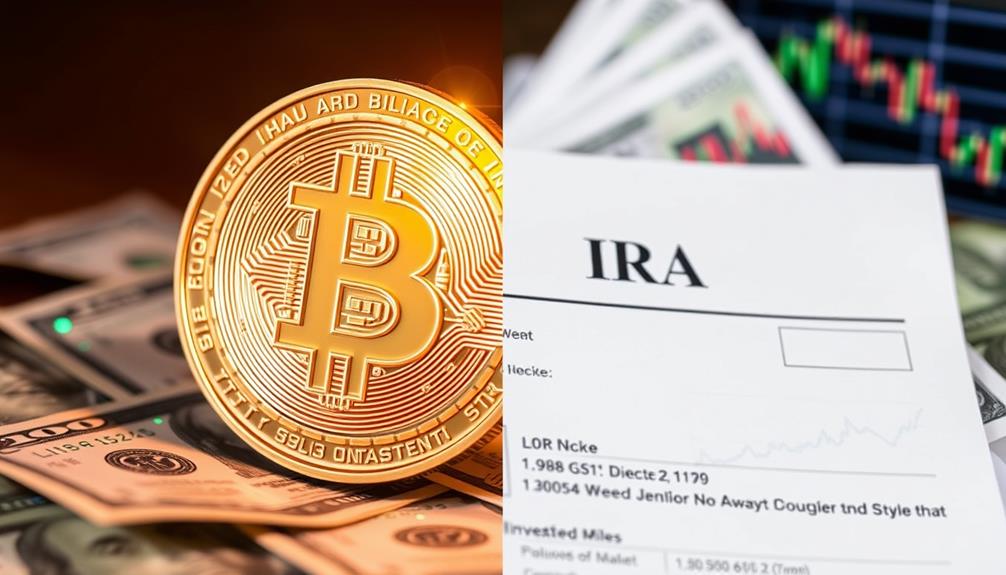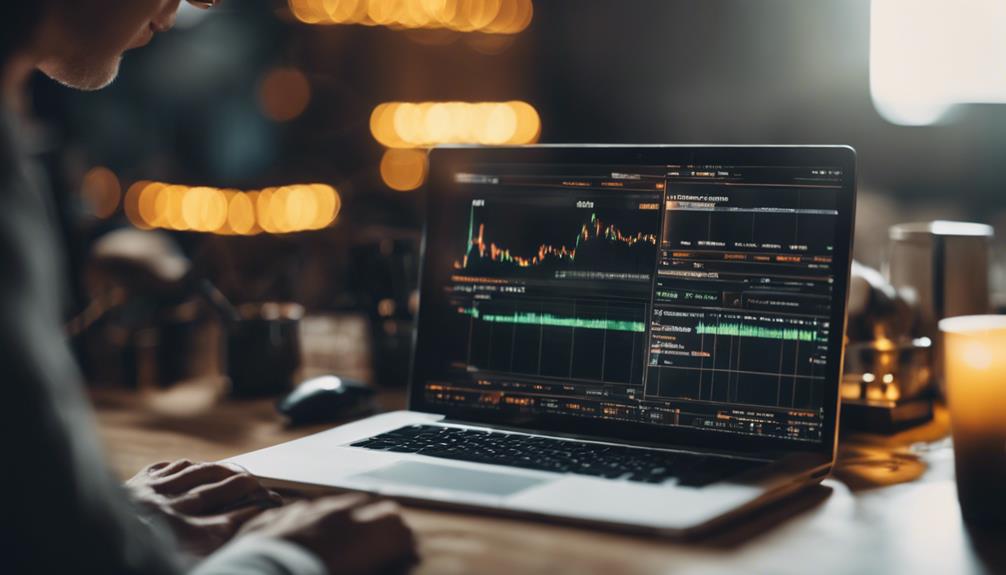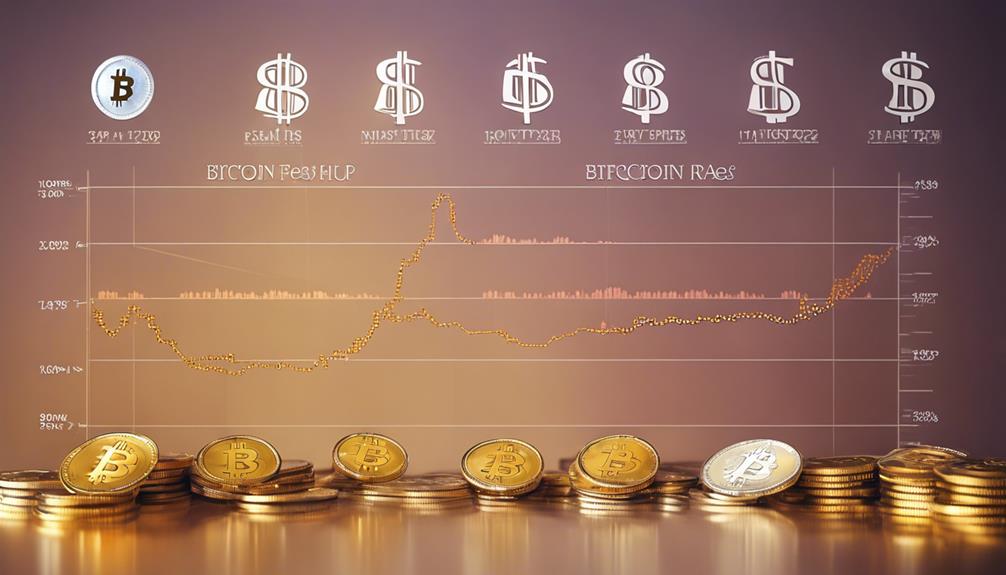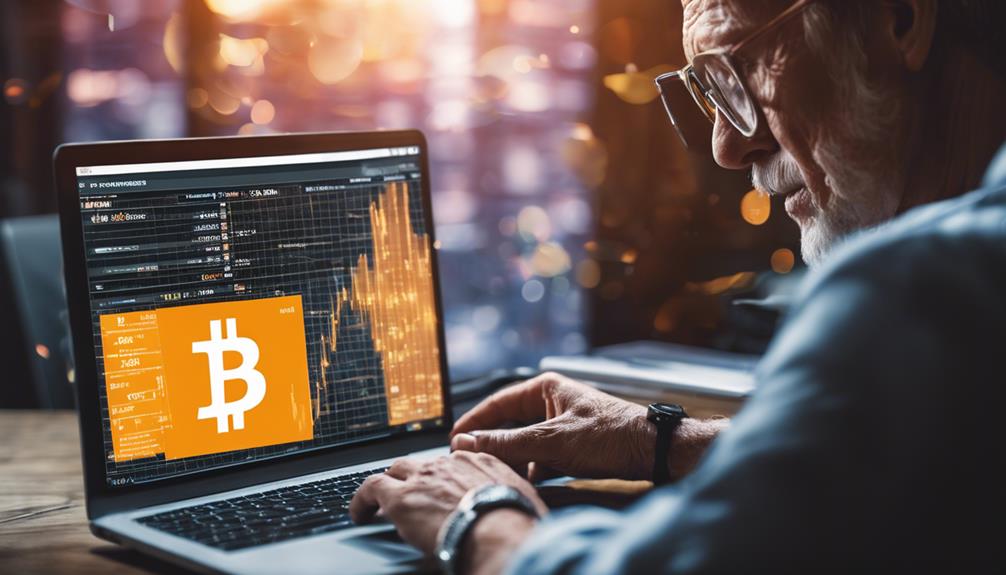Bitcoin halving events have the potential to significantly impact your IRA investments by creating a deflationary effect that often results in increased volatility and price appreciation. Historically, prices have shown a surge following halvings, increasing the possibility of substantial returns. Each halving event reduces the supply of new bitcoins, driving up demand and scarcity. This phenomenon could impact your long-term investment strategy, especially if you are considering diversifying with cryptocurrencies. Understanding these patterns is crucial for making well-informed decisions about your IRA. There is much more to explore regarding the implications of Bitcoin halving on your investment strategy, so continue delving into additional insights.
Key Takeaways
- Bitcoin halving reduces the block reward, creating scarcity which historically drives price appreciation, influencing IRA investment values.
- Past halving events have led to significant price surges, suggesting potential for long-term gains in Crypto IRAs post-halving.
- Institutional interest in cryptocurrencies increases post-halving, potentially enhancing market stability and liquidity for IRA investments.
- Engaging with tax professionals is crucial for navigating IRS regulations and understanding tax implications of Bitcoin investments in IRAs.
- Diversification and long-term strategies, such as dollar-cost averaging, can mitigate risks associated with Bitcoin's volatility in retirement portfolios.
Understanding Bitcoin Halving
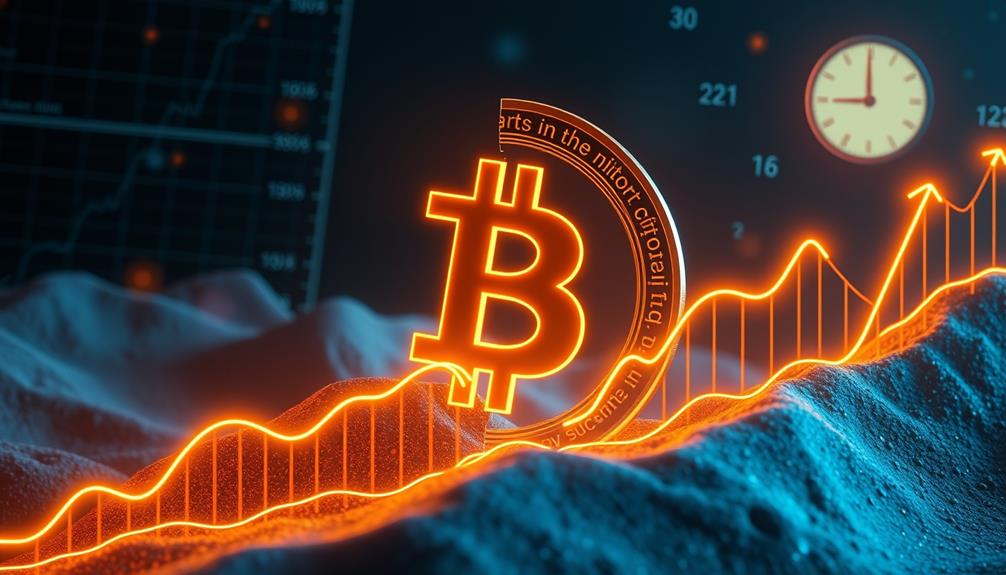
When you plunge into the world of Bitcoin, understanding halving is vital, as it directly influences the cryptocurrency's value and scarcity. Bitcoin halving occurs approximately every four years, specifically every 210,000 blocks, and it cuts the reward for mining by 50%. The most recent halving took place on April 19, 2024, reducing the reward to 3.125 BTC.
This process is important because it limits the supply of Bitcoin, which is capped at 21 million coins by 2140, creating a deflationary dynamic that often drives Bitcoin prices higher. Additionally, just as diversifying your retirement portfolio with gold can protect against inflation and market downturns, understanding the implications of Bitcoin halving can provide a strategic approach to cryptocurrency investments, especially when considering investment strategies in precious metals.
By grasping the implications of Bitcoin halving, you can make informed financial decisions. Each halving event impacts miner profitability, as miners receive fewer rewards, potentially leading to increased competition and changes in mining strategies.
This scarcity can heighten market speculation, making halving a focal point for media attention and investor interest. Ultimately, understanding Bitcoin halving equips you with valuable insights for your investment decisions.
Recognizing how these events shape the Bitcoin blockchain and influence market trends will better prepare you for traversing the volatile cryptocurrency landscape.
Historical Market Trends
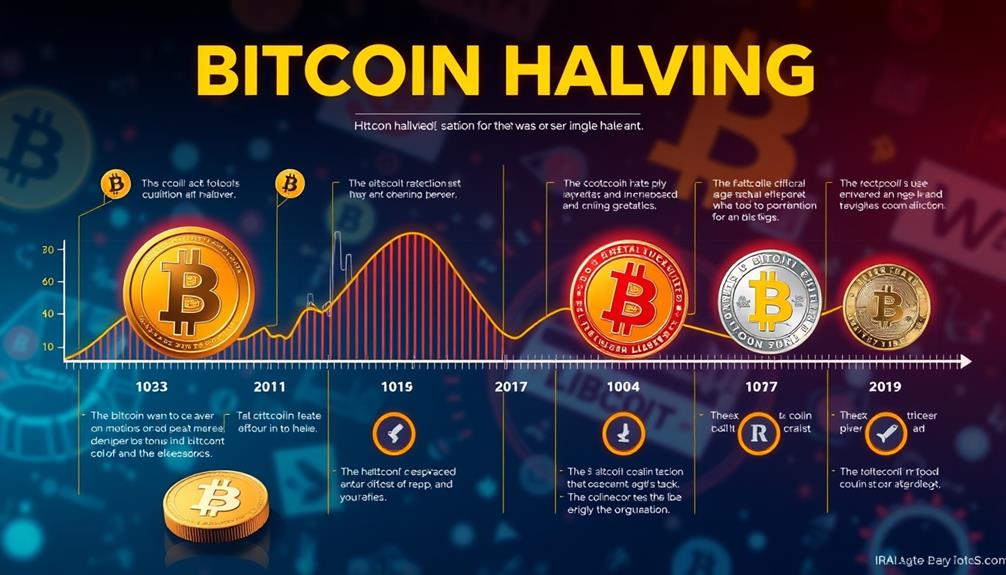
Historical market trends surrounding Bitcoin halving events reveal a compelling pattern of price appreciation that many investors closely monitor. Each halving has historically led to significant price increases, driven by reduced supply and heightened investor interest.
Understanding the concept of diversification strategy is crucial as it can mitigate risks associated with such volatile assets. Here are some key takeaways:
- 2012 Halving: Bitcoin's price surged from about $12 to $1,100 within a year.
- 2016 Halving: Following this event, Bitcoin saw a dramatic rise from around $650 to nearly $20,000 in twelve months.
- 2020 Halving: The price climbed from approximately $8,500 to about $64,000 shortly after the halving, reinforcing the trend of price appreciation linked to supply constraints.
- Market Sentiment: Anticipation of halving events typically creates notable price rallies due to speculative trading behaviors.
In the months following these halvings, volatility tends to increase, with significant inflows into Bitcoin ETFs reflecting rising investor interest.
As supply reduces, the market often experiences this dynamic, making it essential for you to understand these historical trends when considering your IRA investments.
Effects on Mining Profitability

Bitcoin halving events greatly impact mining profitability by cutting block rewards in half, which can strain miners' revenue. The most recent halving on April 19, 2024, reduced the block reward from 6.25 BTC to 3.125 BTC, directly affecting the income of miners. As the supply of new bitcoins decreases, competition for blocks intensifies, particularly with only about 1.3 million bitcoins left to mine.
| Factor | Before Halving | After Halving |
|---|---|---|
| Block Reward | 6.25 BTC | 3.125 BTC |
| Miners' Revenue | Higher | Lower |
| Bitcoin Prices Impact | Variable | Potentially Higher |
Although mining profitability may initially dip post-halving, historical trends show that rising Bitcoin prices often follow these events. This price increase can incentivize miners to continue or expand their operations. However, the sustainability of mining operations is vital for network security; a significant drop in miners could lead to vulnerabilities in the system. Understanding these dynamics is essential for those considering Bitcoin IRAs and their long-term viability.
Future Halving Events

As you look ahead, the next Bitcoin halving is set for April 2028, reducing the mining reward considerably.
Historical trends suggest that these events often lead to notable price increases, creating potential investment opportunities.
Additionally, incorporating Gold IRA options into your retirement strategy may provide a hedge against volatility in the cryptocurrency market.
With around 29 halvings left until the final cap of 21 million bitcoins, understanding these future events could be essential for your IRA investments.
Upcoming Halving Dates
While many investors keep a close eye on market trends, the upcoming Bitcoin halving set for April 19, 2024, is a key event that could greatly impact the cryptocurrency landscape.
This next Bitcoin halving will reduce the block reward from 6.25 BTC to 3.125 BTC, potentially affecting Bitcoin price and supply dynamics. Understanding the risks and rewards of Bitcoin IRAs during this time can provide valuable insights for investment decisions.
Here are four key points to contemplate about upcoming halving events:
- Historical Trends: Previous halvings consistently created upward pressure on Bitcoin price, with significant increases often seen in the months that follow.
- Future Halvings: After the April 2024 event, the next halving is projected for early 2028, further reducing the reward to 1.5625 BTC.
- Total Supply: Currently, about 19.7 million Bitcoins are in circulation, leaving only around 1.3 million left to be mined before reaching the capped total supply of 21 million.
- Impact on Miners: As block rewards decrease, Bitcoin miners will face new economic realities, influencing their operations and strategies.
Understanding these upcoming halving dates can help you make informed decisions about your IRA investments in Bitcoin.
Historical Price Trends
Over the years, historical price trends have showcased a consistent pattern: significant price increases often follow Bitcoin's halving events. For instance, Bitcoin saw remarkable price increases of about 9,100% from 2012 to 2013, 3,500% from 2016 to 2017, and around 1,300% from 2020 to 2021.
With the upcoming 2024 halving reducing the mining reward from 6.25 BTC to 3.125 BTC, many expect similar price appreciation in the months that follow. This pattern of scarcity mirrors the principles seen in Gold IRAs, where limited supply and market conditions can drive value.
In the lead-up to past halvings, market speculation has driven Bitcoin prices to rally dramatically. Before the 2012 halving, prices soared from around $12 to $1,100, while the 2016 halving saw a rise from $650 to $20,000.
As we approach the 2028 halving, which will cut the block reward to 1.5625 BTC, the trend of diminishing supply continues, enhancing scarcity—an essential factor in price movements post-halving.
As of May 2024, with approximately 19.7 million bitcoins mined, only about 1.3 million remain. This limited supply could amplify price increases, making Bitcoin IRAs an exciting investment option for those looking to capitalize on historical trends.
Investment Strategies for Crypto IRAs

Steering through the world of Crypto IRAs requires a thoughtful approach to investment strategies that align with your financial goals and risk tolerance.
As with traditional assets like gold, evaluating the role of cryptocurrencies in your overall portfolio is essential for long-term stability and growth. Here are some effective strategies to take into account:
- Evaluate Your Risk Tolerance: Understand how much volatility you're comfortable with. Bitcoin and altcoins can fluctuate greatly, so knowing your limits helps in making informed decisions.
- Implement Dollar-Cost Averaging: This strategy allows you to invest a fixed amount regularly, which can mitigate the impact of market volatility. By doing so, you'll avoid trying to time the market.
- Adopt a Long-Term Buy-and-Hold Strategy: Historically, Bitcoin halving events have led to considerable price increases in the long run. Staying invested can be beneficial as prices often rise post-halving.
- Diversify Your Crypto IRA: Don't put all your eggs in one basket. By diversifying your Crypto IRA with altcoins, you can capture potential gains from assets that may outperform Bitcoin at different times.
Investing in alternative assets can also serve as a hedge against economic uncertainty, similar to Gold IRA Rollovers.
Risk Factors and Volatility

Maneuvering the volatile landscape of crypto investments requires an understanding of the inherent risks, especially around Bitcoin halving events. Historically, Bitcoin halvings lead to increased price volatility, with notable fluctuations occurring in the months before and after each event. This volatility is often driven by speculative trading, where investors react to changes in miner profitability.
For instance, the most recent halving on April 19, 2024, reduced mining rewards, potentially impacting smaller miners and leading to heightened market fluctuations. Additionally, these events can create opportunities for savvy investors to capitalize on free crypto opportunities that arise from increased market activity.
Historical data reveals that Bitcoin's price has markedly increased after each halving, like the jump from $650 to $20,000 post-2016 halving. However, these price surges come with substantial investment risks. The speculative nature of Bitcoin can trigger rapid shifts in investor sentiment, resulting in unpredictable price movements that could affect your IRA investments.
It's essential to recognize that the volatility surrounding halving events may lead to a potential total loss, as past performance doesn't guarantee future results. Staying informed about market reactions and understanding the risks involved will be key to maneuvering these turbulent waters.
Long-Term Value Considerations

Historically, Bitcoin has demonstrated a pattern of significant long-term value appreciation, particularly in the wake of halving events. Each halving reduces the mining reward, tightening supply and making Bitcoin scarcer. This imbalance between supply and demand often leads to notable price appreciation.
Additionally, many investors view Bitcoin as a hedge against inflation, similar to physical assets like gold, which also thrive during economic uncertainty. Understanding the diversification benefits of incorporating various asset types can further enhance your investment strategy.
Consider these key points about Bitcoin's long-term potential:
- Historical Performance: After the 2012 halving, Bitcoin surged from around $12 to over $1,100.
- Price Reaction: Following the 2016 halving, prices jumped from $650 to nearly $20,000 within a year, illustrating the investment impact of reduced supply.
- Current Scarcity: As of May 2024, only about 1.3 million bitcoins remain to be mined, enhancing Bitcoin's scarcity.
- Future Events: The next halving in 2028 will further reduce the mining reward to 1.625 BTC, likely pushing demand and value even higher.
If you're considering Bitcoin as a digital asset for your IRA, understanding these long-term value considerations can help you make informed decisions.
Keep an eye on historical trends, as they might guide your approach to this evolving investment landscape.
Institutional Interest in Bitcoin

You can't ignore the growing institutional adoption of Bitcoin, especially with major players like BlackRock leading the way.
This shift not only signals increased market confidence but also hints at changes in the regulatory landscape that could further legitimize cryptocurrencies.
With the rise of ESG considerations driving investor preferences, institutions are more likely to evaluate their cryptocurrency investments through the lens of sustainability.
As institutions invest more, you might see significant impacts on market dynamics, particularly around Bitcoin halving events.
Growing Institutional Adoption
Institutional adoption of Bitcoin has skyrocketed in recent years, with major players like BlackRock leading the charge as the largest institutional holder. This surge in interest signifies growing confidence in cryptocurrency as a viable investment asset.
Research shows that 36% of institutional investors have allocated funds to cryptocurrencies, indicating a notable shift in traditional investment strategies. As AI technologies advance, the integration of AI Cybersecurity Jobs will also play an essential role in safeguarding these digital assets from evolving cyber threats.
Here are a few key factors driving this growing trend:
- Financial Institutions' Involvement: Major firms like JPMorgan and Goldman Sachs now offer Bitcoin-related services, enhancing credibility.
- Bitcoin ETFs: The rise of Bitcoin Exchange-Traded Funds provides regulated avenues for institutions to invest in Bitcoin, making it easier to include in future portfolios.
- Investor Sentiment: A Deloitte report reveals that 83% of institutional investors believe digital assets will play a significant role in their portfolios.
- Adaptation to Market Changes: As Bitcoin halving events approach, many institutions see this as an opportunity to strengthen their Bitcoin investments.
With these dynamics at play, the landscape for Bitcoin and other cryptocurrencies looks promising for institutional investors.
Market Confidence Signals
The surge in institutional interest signals a transformative shift for Bitcoin, fostering greater market confidence. With heavyweights like BlackRock emerging as significant holders, this trend indicates a more stable investment landscape.
Historical data shows that when a Bitcoin halving event occurs, increased institutional investment often leads to significant price rallies. As institutional interest in Bitcoin rises, liquidity in the market typically improves, positively influencing price dynamics and investor sentiment.
Moreover, as these institutions adopt Bitcoin, the overall perception of it as a legitimate asset class strengthens. This shift can encourage retail investors to contemplate including Bitcoin in their IRA portfolios, seeing it as a viable long-term investment.
Additionally, favorable regulatory developments are paving the way for even more institutional participation, further enhancing market confidence in Bitcoin.
As you navigate your investment strategy, keeping an eye on these signals can be essential. The involvement of institutional investors not only boosts market confidence but also potentially stabilizes Bitcoin's price, making it an attractive option for your IRA investments.
Regulatory Landscape Changes
As Bitcoin's regulatory landscape evolves, investors are noticing promising changes that could enhance institutional participation. Major players like BlackRock have emerged as notable holders, indicating growing confidence in cryptocurrency investments.
This shift in institutional interest could lead to several key developments:
- Regulatory Developments: Governments are working on frameworks that could make Bitcoin more accessible.
- Mainstream Adoption: Increased involvement from financial institutions may legitimize Bitcoin, encouraging more investors to participate in the Bitcoin market.
- Custodians Compliance: More custodians are aligning with regulations, which can improve how Bitcoin is held in retirement accounts, including Crypto IRAs.
- Demand and Price Appreciation: As institutional demand remains high, you might see increased price appreciation, influencing your investment strategies.
These changes could greatly impact your cryptocurrency investments, especially if you're considering Bitcoin for your retirement portfolio.
With evolving regulations and growing institutional interest, now might be the time to explore how Bitcoin halving events could further influence your investment decisions amidst this dynamic regulatory landscape.
Navigating Regulatory Implications

Steering through the regulatory implications of Bitcoin investments in IRAs requires careful consideration of several factors. As you consider integrating cryptocurrency into your IRA, it's vital to understand that Bitcoin isn't classified as legal tender by the U.S. government. This classification influences how your investments are treated and can increase the risks associated with managing your IRA.
Self-directed IRAs that include cryptocurrency assets lack endorsement from the IRS or government agencies. This means you must be aware of the unique risks and absence of regulatory protection.
Additionally, tax implications can vary considerably, as you might be subject to capital gains tax on profits realized from Bitcoin transactions within your IRA.
The regulatory landscape around cryptocurrencies is evolving, which could lead to changing compliance requirements for Crypto IRAs. Consequently, ongoing education is important.
It's advisable to consult with tax professionals and legal advisors to confirm your investments comply with IRS regulations and to fully understand potential tax liabilities. By staying informed, you can navigate the complexities of Bitcoin halving events and safeguard your IRA investments.
Frequently Asked Questions
Can I Hold Bitcoin in My Ira?
Yes, you can hold Bitcoin in your IRA through a self-directed IRA. You'll need to work with qualified custodians to facilitate your investments, but remember, these investments come with significant risks and volatility.
What Does Bitcoin Halving Mean for Investors?
Bitcoin halving means reduced mining rewards, which can lead to increased scarcity. As an investor, you might see price appreciation following halvings, but be prepared for potential volatility and adjust your strategies accordingly.
How Safe Is Bitcoin Ira?
Investing in a Bitcoin IRA is like riding a rollercoaster; it can be thrilling yet unpredictable. You're exposed to significant risks, including market volatility and regulatory changes, so make certain you fully understand these before diving in.
What Are the Implications of Bitcoin Halving?
Bitcoin halving reduces the supply of new bitcoins, often leading to increased demand and potential price appreciation. You might see heightened investor sentiment and speculation, impacting market dynamics and influencing your investment decisions.
Conclusion
As you navigate the world of Bitcoin halving, remember that the early bird catches the worm. Staying informed about historical trends and future events can help you make smarter decisions for your IRA investments. While the potential for profit is enticing, don't overlook the risks and volatility inherent in crypto. By balancing your investment strategies with long-term value considerations, you can ride the waves of this dynamic market and potentially reap significant rewards.
Helen brings a wealth of experience in investment strategy and a deep passion for helping individuals achieve their retirement goals. With a keen understanding of market dynamics, Helen has been instrumental in shaping the vision and direction of Gold IRA Markets. She specializes in creating innovative solutions that align with our clients’ long-term investment objectives.
